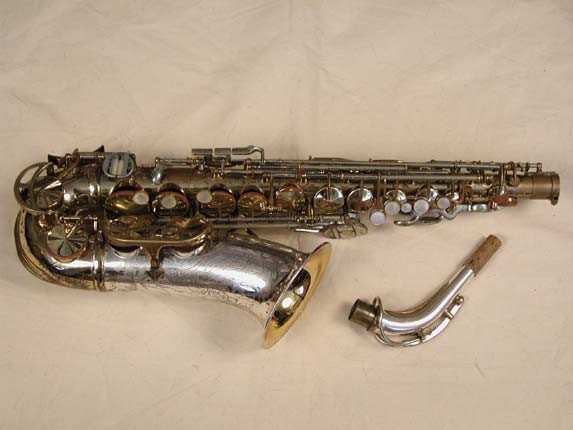
#King super 20 alto saxophone sliversonic series#
Judging by the pictures, I think that the tenor I played most closely resembled the Series IV. They still only live about 5 minutes away from me. In the meantime, I think I'll give these guys a call. One day when I can justify the cost, I will purchase a King Super 20. All in all, I loved this horn and the time I spent with it. The owner stated that he would like to get the neck de-lacquered and silver plated to cover up the blemish. This horn did take a hit to the neck many years ago, and there is still evidence of a horrific bend that was removed by a competent tech. I think that vintage American tenors sound best in the lowest registers, and that's the biggest separation from their modern and French counterparts, but that's just my opinion. From my experience, the only tenor that subtoned better was the aforementioned Buescher 400. Subtoning was a cinch, and it sounded great. Actually, the horn was rather on the bright side. The tone was considerably more spread than any Selmer, but it wasn't dark. This tenor also had the least resistance of any tenor saxophone I've ever played. Playing on this horn instantly made me think of King Curtis, Clarence Clemmons, and Boots Randolph. Regarding tone, the owner had made a statement that with the Dukeoff mouthpiece you could make a growl tone that sounded like bacon sizzling on the griddle. The table keys are a good design, but not quite as nimble as the SBA/Mark VI layout. Despite this, the action was surprisingly light, but the ergonomics clearly favored larger handed players as the stack keys feel more spread out than other horns. Key cups on King saxophones always look larger than other makes, and this 20 was no exception.

This horn did not have a double socket neck either. It did not sport a true underslung like the Conn 6M did. This particular one still had the underslung styled octave mechanism similar to the modern Yanagisawas. Of course you have to remember that the design of these horns changed dramatically through the years. The Super 20 in my mind is the most modern feeling vintage American horn. I would say that the horn was in near perfect mechanical condition when I played it. He is a mechanical engineer by occupation, so his woodwind work is pretty darn good. The pads and action of this tenor was regularly maintained by the owner. Oddly, I've read reports of players wearing holes in these horns around the RH thumbhook. The metal on these old Kings seems very thick and rigid to me. Off the bat this was the heaviest tenor I've ever played. I used the horn for several weeks, and it was a very enjoyable experience. Both were great horns, but I chose the 20 with the recommended Dukeoff metal mouthpiece. This was before I even owned a tenor myself, so I was given the choice of using either the Super 20, or a post Selmer buyout Buescher 400 (also his fathers horn). My friend then asked me if I wanted to play tenor for these games.


Unfortunately, the games conflicted with our 1st tenor's work schedule. We had a series of school basketball games that the jazz band had to play for this year. Actually, it was cool working with the kid because we constantly swapped parts and I had many more opportunities than what most 2nd chairs get. Anyway's, I played 2nd alto in the school's jazz program next to his son who played 1st. He told me that if he would have known what the VI's would one day go for, he would have saved up and invested in every VI the store had in stock. He liked the VI's, but decided to save a few bucks and used that money to buy a brand new (then) Bobby Dukeoff mouthpiece with the horn. I think he bought the horn brand new for $300 back when he was in high school. My high school friend's father owns a Super 20 from the early 70's. I played a Super 20 extensively during my senior year in high school. The tenor I played had good intonation and tone. The later intermediate models are decent.

The tenor did fair a little better than the alto. I'm usually very good at adjusting to a horns intonation issues, but I just could not pull it off with the Voll-True. I'm used to playing on Martin Committee's and New Wonder's, but I could not humor the pitch as well on these horns. My opinion of the intonation is that it is sketchy. Like Ed says, they are bright and powerful.


 0 kommentar(er)
0 kommentar(er)
